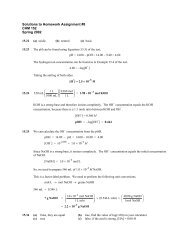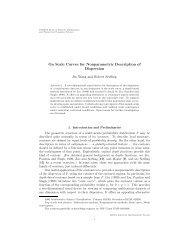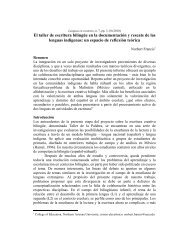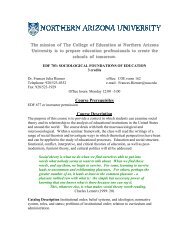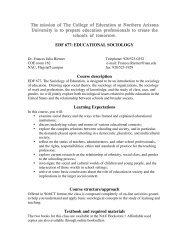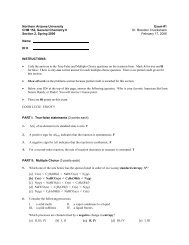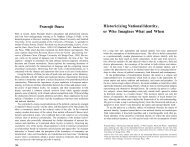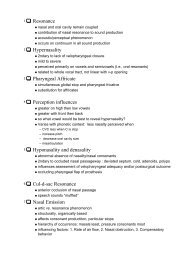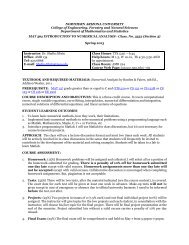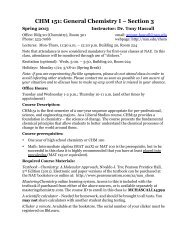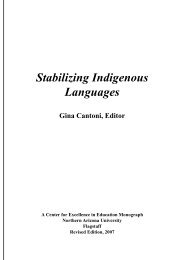Phylum Nematomorpha - Jan.ucc.nau.edu
Phylum Nematomorpha - Jan.ucc.nau.edu
Phylum Nematomorpha - Jan.ucc.nau.edu
Create successful ePaper yourself
Turn your PDF publications into a flip-book with our unique Google optimized e-Paper software.
Blastocoelomates,<br />
Continued<br />
<strong>Phylum</strong><br />
Loricifera<br />
General Characteristics:<br />
b. N species unknown,<br />
now about 35-40.<br />
2. Bilaterally, radially<br />
symmetrial, unsegmented,<br />
apparently<br />
psuedocoelomate.<br />
Locomotion:<br />
e. Appear to propel<br />
themselves along with<br />
spines and toes.<br />
<strong>Phylum</strong><br />
Loricifera<br />
General Characteristics:<br />
1. A recently discovered<br />
phylum (Kristensen 1983)<br />
from shell-gravel<br />
sediments.<br />
a. Now know to occur at<br />
great depth.<br />
Body Form:<br />
a. Extremely tiny, 1/4<br />
mm long.<br />
b. Head, neck, and thorax<br />
retractable into abdomen.<br />
1. Spines encircle coneshaped<br />
mouth.<br />
c. All surrounded by<br />
cuticle - lorica ("corsetbearers").<br />
d. complete gut, diet?<br />
Reproduction:<br />
a. Poorly known like rest<br />
of group.<br />
b. Sexes separate,<br />
sexually dimorphic in<br />
head scales.<br />
c. unique "Higgins-larva"<br />
named after codiscoverer.<br />
1. originally thought to be<br />
a larval priapulan.
<strong>Phylum</strong><br />
Priapula<br />
General Characteristics:<br />
1. Named after the Greek<br />
god Priapos, although<br />
actual name-sake reported<br />
by B&B to be from<br />
Linnaeus (Priapus<br />
humanus) - human penis.<br />
Body Form:<br />
a. Bilaterally<br />
symmetrical, superficially<br />
annulated.<br />
b. Armed anterior end<br />
(introvert) that is<br />
retractable.<br />
1. Burrowing forms,<br />
structure assists in food<br />
capture.<br />
Body Form:<br />
c. Radially arranged<br />
nervous system located<br />
near surface of body<br />
d. Complete gut - often<br />
with diverticulae.<br />
e. Numerous<br />
protonephridia associated<br />
with the reproductive<br />
tract.<br />
<strong>Phylum</strong><br />
Priapula<br />
Priapus humanus<br />
a. Reported to be 20 cm<br />
long (>9 inches!)<br />
b. Anterior end armed<br />
with spikes.<br />
Feeding:<br />
a. Extend introvert, hook prey, contract<br />
muscles and draw prey in.<br />
1. Amounts to a true urogenital system -<br />
observed in more derived forms.<br />
2. May assist habitation of sediments in hypoand<br />
hypersaline environments.
Body Form:<br />
f. Unique (apparently) respiratory structure<br />
- caudal appendage.<br />
1. No apparent effect if removed, however.<br />
With<br />
Pseudocoels?<br />
1. Cuticle, periodially<br />
shed (Ecdysozoa).<br />
2. Fluid filled body<br />
cavity, movement<br />
assisted by hydrostatic<br />
pressure.<br />
3. lorica-encased larva<br />
- very similar to<br />
Loriciferans.<br />
Reproduction:<br />
a. Gonochoristic, but<br />
copulation doesn't occur –<br />
spawning instead.<br />
b. Males first, female<br />
second - interesting, this<br />
is unusual for external<br />
fertilizers.<br />
Phylogenetic<br />
Position:<br />
3. Unusual groupdifficult<br />
to place due to<br />
affinities to pseudocoels<br />
and eucoels.<br />
With Eucoels?<br />
1. Body wall is lined - but<br />
lining does not cover<br />
internal organs.<br />
2. Yet extensions do<br />
support viscera.<br />
3. Overall, difficult to<br />
classify.<br />
Development:<br />
c. Is unusual for<br />
pseudocoels: radial<br />
holoblastic cleavage.<br />
d. Produces loricate<br />
larva.
<strong>Phylum</strong><br />
<strong>Nematomorpha</strong><br />
General Characteristics<br />
1. Wierd, once thought to<br />
represent spontaneous<br />
generation.<br />
a. Adults occur in horse<br />
troughs.<br />
b. attempts to revitalize<br />
horsehairs failed.<br />
<strong>Phylum</strong> <strong>Nematomorpha</strong><br />
General<br />
Characteristics:<br />
2. Longitudinal<br />
muscles.<br />
3. No ciliated<br />
structures.<br />
<strong>Phylum</strong><br />
<strong>Nematomorpha</strong><br />
General Characteristics<br />
2. Fairly abundant - 230<br />
spp<br />
3. Body form<br />
a. Similar to nematodes<br />
1. thick cuticle must be<br />
molted.<br />
<strong>Phylum</strong><br />
<strong>Nematomorpha</strong><br />
Dissimilar to Nematodes.<br />
1. Do not show<br />
consistency in cell<br />
number (eutely).<br />
2. Pseudocoel filled with<br />
mesenchyme.<br />
3. Rudimentary digestive<br />
system.<br />
<strong>Phylum</strong><br />
<strong>Nematomorpha</strong><br />
Dissimilar to Nematodes.<br />
a. nutrients absorbed from<br />
body of insect host.<br />
3. No excretory system<br />
4. No specialized genital<br />
system - cloacas in both<br />
sexes.
<strong>Phylum</strong><br />
<strong>Nematomorpha</strong><br />
Reproduction -<br />
a. Example: Gordius<br />
after the Gordian Knot.<br />
1. intricate knot tied by<br />
King Gordius of Phrygia<br />
a. whoever untied it<br />
would be King of Asia.<br />
<strong>Phylum</strong><br />
<strong>Nematomorpha</strong><br />
Life Cycle:<br />
a. Adults develop in<br />
bodies of insects.<br />
1. Cause them to seek<br />
water, once entering, they<br />
explode.<br />
2. Separate sexes mate in<br />
water.<br />
<strong>Phylum</strong><br />
<strong>Nematomorpha</strong><br />
Life Cycle:<br />
4. Larvae ingested by<br />
host- when insects feed or<br />
drink near water.<br />
a. Use hooked proboscis<br />
to imbed in tissues<br />
<strong>Phylum</strong> <strong>Nematomorpha</strong><br />
b. Alexander cut it with his sword and<br />
became King of Phrygia<br />
<strong>Phylum</strong><br />
<strong>Nematomorpha</strong><br />
Life Cycle:<br />
a. Females lay eggs that<br />
wrap around aquatic<br />
vegetation.<br />
3. Eggs hatch, larvae<br />
remain free living for<br />
only a few days.<br />
<strong>Phylum</strong><br />
<strong>Nematomorpha</strong><br />
Life Cycle:<br />
b. If unsuitable host<br />
ingests, will encyst and<br />
wait for intermediate host<br />
to be ingested by suitable<br />
host.<br />
1. Beetle -> mantid
<strong>Phylum</strong><br />
<strong>Nematomorpha</strong><br />
2. Can also inhabit<br />
annelids, molluscs,<br />
crustceans, humans<br />
5. Mature worm develops<br />
beneath skin.<br />
<strong>Phylum</strong><br />
Entoprocta<br />
General Characteristics<br />
b. Derivation of "entoproct"<br />
-anus within ring<br />
of tentacles.<br />
c. Kamptozoa - derived<br />
from flexible calyx that<br />
permits<br />
zoids to "nod."<br />
<strong>Phylum</strong> Entoprocta<br />
Cilia draw water from beneath tentacles.<br />
a. Food swept to mouth, anus within ring of tentacles.<br />
<strong>Phylum</strong><br />
Entoprocta<br />
(Kamptozoa)<br />
General Characteristics<br />
1. Usually colonial<br />
organisms with upright<br />
zooids.<br />
a. ciliated tentacles<br />
surrounding the mouth<br />
and anus.<br />
<strong>Phylum</strong> Entoprocta<br />
2. Appear related to other similar groups:<br />
a. Bryozoans - ectoprocts<br />
b. but similarity is ecological rather than<br />
evolutionary.<br />
<strong>Phylum</strong><br />
Entoprocta<br />
Reproduction<br />
a. Capable of<br />
reproduction by budding -<br />
hence colonial structure.<br />
b. Also sexual<br />
reproduction.
<strong>Phylum</strong> Entoprocta<br />
1. Sperm released into water; internal fertilization.<br />
3. Ciliated larva that is similar to that of annelids and<br />
molluscs.<br />
<strong>Phylum</strong><br />
Acanthocephala<br />
<strong>Phylum</strong><br />
Entoprocta<br />
4. Some to suggest that<br />
entoprocts are highly<br />
derived, share a common<br />
ancestor with these<br />
groups.<br />
a. Lack of body cavity<br />
represents a neotenic<br />
character.
Rhabditiform larva of a<br />
hookworm<br />
Caenorhabditis elegans<br />
Dracunculus medinensis larvae<br />
Onchocerca volvulus Loa loa
Anchylostoma (Ancylostoma) sp.<br />
anterior end<br />
Necator americanus<br />
Strongyloides filariform larva Strongyloides filariform larva




